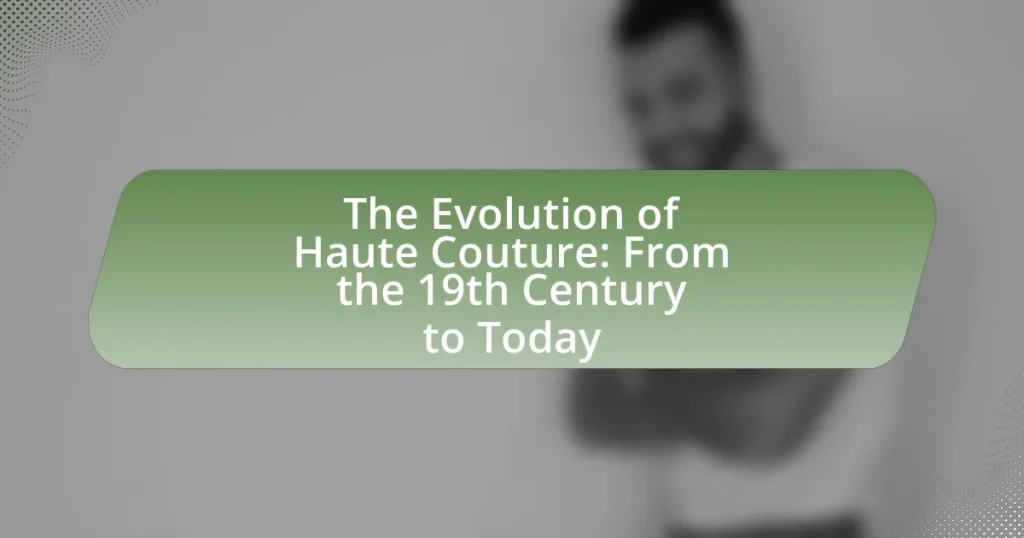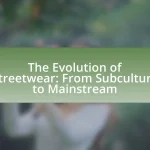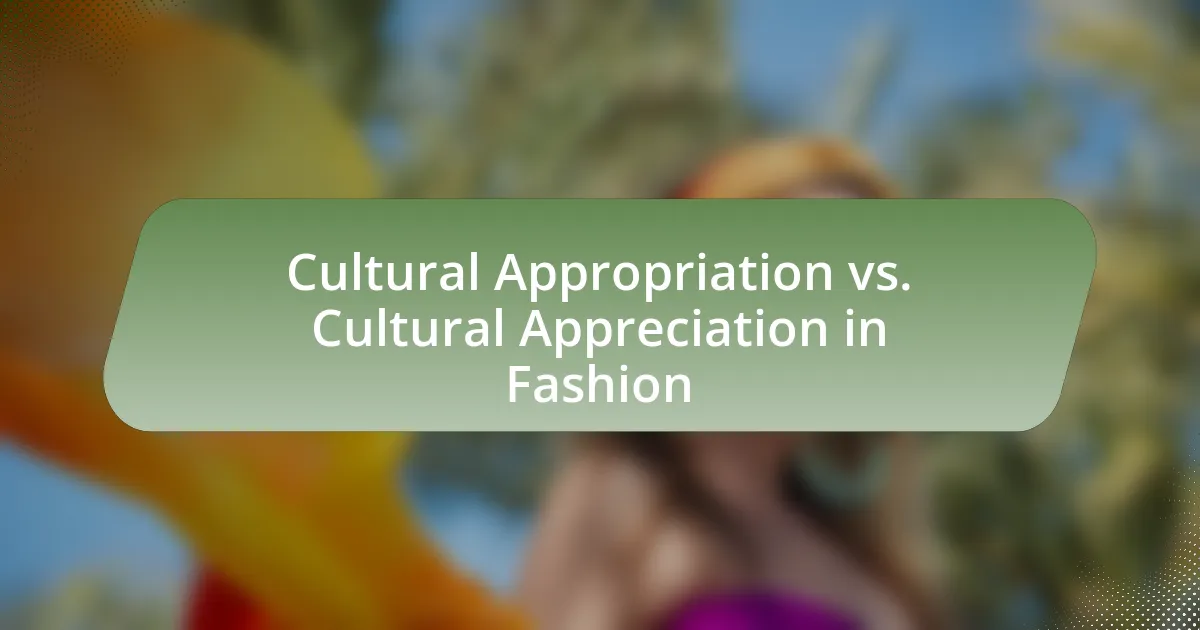Haute Couture, defined as the creation of exclusive, custom-fitted clothing by high-end fashion houses, has a rich historical significance that dates back to the mid-19th century. The article explores its origins with Charles Frederick Worth, the establishment of the first fashion house in Paris, and the subsequent formalization of the industry through the Chambre Syndicale de la Haute Couture. It examines key figures who shaped Haute Couture, the defining characteristics of early designs, and how the movement reflects cultural and societal changes. Additionally, the article discusses the evolution of Haute Couture through the decades, the impact of technology and sustainability on modern practices, and the current state of the industry, highlighting the challenges and future trends that will define Haute Couture in the coming years.

What is Haute Couture and its Historical Significance?
Haute Couture refers to the creation of exclusive, custom-fitted clothing made by high-end fashion houses, characterized by meticulous craftsmanship and luxurious materials. Historically, haute couture emerged in the mid-19th century, with figures like Charles Frederick Worth, who is often regarded as the father of haute couture, establishing the first fashion house in Paris in 1858. This movement not only revolutionized fashion by introducing the concept of designer labels but also set the foundation for the modern fashion industry, influencing trends and standards of luxury. The establishment of the Chambre Syndicale de la Haute Couture in 1945 further solidified its significance by regulating and promoting the haute couture industry, ensuring that it remained synonymous with artistry and exclusivity.
How did Haute Couture originate in the 19th century?
Haute Couture originated in the 19th century with the establishment of the first fashion house by Charles Frederick Worth in Paris around 1858. Worth is recognized as the father of Haute Couture because he introduced the concept of creating exclusive, custom-fitted garments for wealthy clients, showcasing his designs on live models rather than through illustrations. This practice marked a significant shift in fashion, as it emphasized individuality and craftsmanship, leading to the formalization of the Haute Couture industry. The Chambre Syndicale de la Haute Couture was later established in 1868 to regulate and promote this high fashion sector, further solidifying its importance in the fashion world.
Who were the key figures in the establishment of Haute Couture?
The key figures in the establishment of Haute Couture include Charles Frederick Worth, who is often regarded as the father of Haute Couture, and established the first fashion house in Paris in the mid-19th century. Worth’s innovative designs and the introduction of the fashion show concept set the foundation for the industry. Additionally, designers like Paul Poiret and Coco Chanel played significant roles in shaping Haute Couture in the early 20th century, with Poiret introducing more liberated silhouettes and Chanel revolutionizing women’s fashion with her modern, casual designs. These figures collectively contributed to the evolution and recognition of Haute Couture as a prestigious art form in fashion.
What were the defining characteristics of early Haute Couture?
Early Haute Couture was characterized by bespoke tailoring, luxurious fabrics, and intricate craftsmanship. This fashion movement emerged in the mid-19th century, primarily associated with designers like Charles Frederick Worth, who is often regarded as the father of Haute Couture. The garments were custom-made for individual clients, emphasizing exclusivity and personalization. Additionally, early Haute Couture showcased elaborate designs, often featuring detailed embroidery and embellishments, which reflected the opulence of the era. The establishment of the Chambre Syndicale de la Haute Couture in 1868 further solidified the standards and practices of this fashion segment, ensuring that only the highest quality and craftsmanship were recognized as true Haute Couture.
Why is Haute Couture considered an art form?
Haute Couture is considered an art form because it embodies exceptional craftsmanship, creativity, and individuality in fashion design. The intricate techniques used in Haute Couture, such as hand-sewing, embroidery, and the use of luxurious materials, elevate garments to the level of artistic expression. Historical examples, like the work of designers such as Charles Frederick Worth in the 19th century, demonstrate how these creations are not merely clothing but wearable art, showcasing innovation and personal vision. The exclusivity and bespoke nature of Haute Couture further reinforce its status as an art form, as each piece is tailored specifically for an individual client, reflecting their unique identity and style.
What techniques differentiate Haute Couture from ready-to-wear fashion?
Haute Couture is differentiated from ready-to-wear fashion primarily by its bespoke tailoring techniques and the use of high-quality, often luxurious materials. Haute Couture garments are custom-made for individual clients, involving extensive handcrafting and intricate detailing, which can include techniques such as draping, embroidery, and the use of unique fabrics that are not mass-produced. In contrast, ready-to-wear fashion is produced in standard sizes and is designed for mass consumption, utilizing more automated manufacturing processes. The exclusivity and craftsmanship inherent in Haute Couture are evidenced by the requirement for designers to be members of the Chambre Syndicale de la Haute Couture, which mandates adherence to specific standards, including a minimum number of fittings and the use of high-quality materials.
How does Haute Couture reflect cultural and societal changes?
Haute Couture reflects cultural and societal changes by serving as a visual representation of the prevailing values, norms, and technological advancements of its time. For instance, during the 19th century, the rise of industrialization and the middle class influenced designers to create more accessible yet luxurious garments, showcasing a shift towards democratization in fashion. Additionally, the post-World War II era saw a return to femininity in fashion, exemplified by Christian Dior’s “New Look,” which mirrored societal desires for stability and traditional gender roles after the war. Furthermore, contemporary Haute Couture often incorporates elements of social activism and diversity, reflecting current movements for inclusivity and representation in society. This evolution demonstrates how Haute Couture not only adapts to but also influences cultural narratives and societal shifts.

How has Haute Couture evolved through the decades?
Haute Couture has evolved significantly through the decades, transitioning from the structured, opulent designs of the 19th century to the more diverse and innovative styles seen today. In the late 1800s, Charles Frederick Worth established the foundation of Haute Couture by creating exclusive garments for wealthy clients, emphasizing craftsmanship and luxury. The early 20th century saw designers like Coco Chanel and Christian Dior introduce revolutionary silhouettes, such as the flapper dress and the New Look, which reshaped women’s fashion.
The 1960s and 1970s marked a period of experimentation, with designers like Yves Saint Laurent incorporating ready-to-wear elements and embracing youth culture. By the 1980s and 1990s, Haute Couture began to reflect global influences and street style, as designers like Jean-Paul Gaultier and Alexander McQueen pushed boundaries with avant-garde creations. In the 21st century, the rise of digital technology and social media has further transformed Haute Couture, allowing for greater accessibility and a blend of traditional techniques with contemporary aesthetics. This evolution illustrates how Haute Couture has continuously adapted to cultural shifts and societal changes while maintaining its core values of exclusivity and artistry.
What major trends shaped Haute Couture in the 20th century?
Major trends that shaped Haute Couture in the 20th century include the rise of ready-to-wear fashion, the influence of World War I and II on design, and the emergence of iconic designers like Coco Chanel and Christian Dior. The shift towards ready-to-wear began in the 1920s, making high fashion more accessible to the public. World War I led to more practical designs, while World War II saw a return to femininity with Dior’s “New Look” in 1947, which emphasized an hourglass silhouette. These trends collectively transformed Haute Couture, reflecting societal changes and evolving consumer demands.
How did World War I and II impact Haute Couture?
World War I and II significantly transformed Haute Couture by altering fashion production and consumer behavior. During World War I, the scarcity of materials led designers to adopt simpler silhouettes and practical designs, as exemplified by the shift towards more utilitarian clothing. This trend continued into World War II, where fabric rationing and economic constraints further influenced designers to create garments that were both functional and stylish, such as the iconic “New Look” introduced by Christian Dior in 1947, which emphasized femininity after years of wartime austerity. The wars also prompted a move towards ready-to-wear fashion, as the demand for accessible clothing increased due to changing societal roles and economic conditions.
What role did iconic designers play in the evolution of Haute Couture?
Iconic designers have been pivotal in the evolution of Haute Couture by establishing its standards, aesthetics, and cultural significance. Designers such as Charles Frederick Worth, often regarded as the father of Haute Couture, set the foundation in the mid-19th century by introducing the concept of the fashion house and personalized fittings, which elevated the status of bespoke clothing. Later, figures like Coco Chanel revolutionized women’s fashion by introducing more practical and comfortable designs, while Christian Dior’s “New Look” in 1947 redefined femininity and luxury in post-war fashion. These designers not only influenced trends but also shaped the business model of Haute Couture, making it a symbol of exclusivity and artistry, thus solidifying its place in the fashion industry.
How has technology influenced Haute Couture in recent years?
Technology has significantly influenced Haute Couture in recent years by enhancing design processes and production efficiency. Innovations such as 3D printing and computer-aided design (CAD) have allowed designers to create intricate patterns and structures that were previously impossible or time-consuming to achieve. For instance, brands like Iris van Herpen have utilized 3D printing to produce avant-garde garments that push the boundaries of traditional fashion design. Additionally, digital fabric printing enables the rapid production of unique textiles, allowing for greater customization and creativity in collections. These technological advancements not only streamline the production process but also expand the artistic possibilities within Haute Couture, reflecting a modern fusion of craftsmanship and innovation.
What innovations have emerged in fabric and design techniques?
Innovations in fabric and design techniques include the development of smart textiles, 3D printing, and sustainable materials. Smart textiles, which integrate technology into fabrics, allow for functionalities such as temperature regulation and moisture management, enhancing user experience. 3D printing has revolutionized design by enabling the creation of complex structures and customized garments, reducing waste and production time. Sustainable materials, such as organic cotton and recycled polyester, have gained prominence, addressing environmental concerns and promoting eco-friendly practices in the fashion industry. These advancements reflect a shift towards innovation that prioritizes both functionality and sustainability in haute couture.
How has digital media changed the marketing of Haute Couture?
Digital media has transformed the marketing of Haute Couture by enabling direct engagement with consumers and expanding brand visibility through online platforms. Traditional marketing methods relied heavily on exclusive fashion shows and print media, limiting audience reach. In contrast, digital media allows Haute Couture brands to showcase collections via social media, websites, and live-streamed events, reaching a global audience instantly. For instance, brands like Chanel and Dior utilize Instagram to share behind-the-scenes content and engage with followers, significantly increasing their market presence. This shift has led to a more interactive relationship between designers and consumers, fostering brand loyalty and driving sales through e-commerce channels.

What is the current state of Haute Couture today?
The current state of Haute Couture is characterized by a blend of traditional craftsmanship and modern innovation, with a focus on sustainability and inclusivity. Major fashion houses like Chanel, Dior, and Valentino continue to showcase intricate designs that reflect both heritage and contemporary aesthetics, while new designers are emerging to challenge the status quo. The Haute Couture market has seen a resurgence in interest, with a reported growth of 20% in 2022, indicating a renewed consumer appetite for bespoke luxury. Additionally, the integration of digital technology, such as virtual fashion shows and online customization, is reshaping how Haute Couture is presented and consumed, making it more accessible to a global audience.
How do contemporary designers interpret Haute Couture?
Contemporary designers interpret Haute Couture as a blend of traditional craftsmanship and modern innovation, emphasizing personalization and inclusivity. This interpretation reflects a shift from the exclusivity of classic Haute Couture to a more accessible approach, where designers like Iris van Herpen and Schiaparelli incorporate technology and sustainable practices into their creations. For instance, van Herpen utilizes 3D printing techniques to create intricate designs, showcasing how contemporary methods can enhance the artistry of Haute Couture. This evolution highlights a commitment to both heritage and forward-thinking, allowing designers to redefine luxury in a way that resonates with today’s diverse clientele.
What are the current challenges facing the Haute Couture industry?
The current challenges facing the Haute Couture industry include the decline in consumer demand, high production costs, and the impact of digital transformation. Consumer interest in luxury fashion has shifted towards ready-to-wear collections, leading to decreased sales for Haute Couture, which typically requires significant investment and time. Additionally, the costs associated with skilled labor and high-quality materials have risen, making it difficult for brands to maintain profitability. The digital landscape has also transformed how consumers engage with fashion, necessitating a shift in marketing strategies and the need for Haute Couture houses to adapt to online platforms while preserving their exclusive image.
How do sustainability and ethical practices influence modern Haute Couture?
Sustainability and ethical practices significantly influence modern Haute Couture by driving designers to adopt environmentally friendly materials and transparent production processes. This shift is evident as many luxury brands now prioritize sustainable sourcing, such as using organic fabrics and recycled materials, to reduce their ecological footprint. For instance, brands like Stella McCartney have pioneered the use of vegan leather and sustainable textiles, showcasing that high fashion can align with eco-conscious values. Additionally, ethical labor practices are increasingly emphasized, with designers ensuring fair wages and safe working conditions for garment workers, reflecting a broader societal demand for corporate responsibility in the fashion industry. This transformation not only appeals to a growing consumer base that values sustainability but also sets a new standard for luxury fashion, reinforcing the idea that Haute Couture can be both exquisite and responsible.
What role does Haute Couture play in the fashion industry today?
Haute Couture plays a crucial role in the fashion industry today by serving as a benchmark for creativity, craftsmanship, and exclusivity. It represents the pinnacle of fashion design, showcasing the highest level of artistry and tailoring, which influences ready-to-wear collections and trends. The Chambre Syndicale de la Haute Couture, the governing body in Paris, sets strict criteria for what qualifies as Haute Couture, ensuring that it remains synonymous with luxury and bespoke craftsmanship. This exclusivity is evidenced by the limited number of clients who can afford such garments, often resulting in pieces that are not only fashion statements but also investment items. Additionally, Haute Couture serves as a platform for designers to experiment with innovative techniques and materials, pushing the boundaries of fashion and inspiring the broader industry.
How does Haute Couture influence mainstream fashion trends?
Haute Couture significantly influences mainstream fashion trends by setting high standards for creativity, craftsmanship, and exclusivity. Designers in the Haute Couture sector often introduce innovative designs, fabrics, and techniques that later permeate ready-to-wear collections. For instance, the introduction of intricate embroidery and unique silhouettes in Haute Couture shows, such as those by Chanel and Dior, often inspires mass-market brands to adopt similar styles, making them accessible to a broader audience. Historical evidence shows that trends like the “New Look” by Dior in 1947 revolutionized women’s fashion, leading to widespread adoption of cinched waists and fuller skirts in everyday clothing. This cyclical relationship between Haute Couture and mainstream fashion ensures that high fashion remains a driving force in shaping consumer preferences and industry standards.
What is the significance of Haute Couture in luxury branding?
Haute Couture is significant in luxury branding as it represents the pinnacle of craftsmanship, exclusivity, and artistic expression in fashion. This high-end segment of the fashion industry not only sets trends but also establishes a brand’s identity and prestige. For instance, the Chambre Syndicale de la Haute Couture in Paris regulates the standards for Haute Couture, ensuring that garments are made to order for individual clients and crafted from high-quality materials, which reinforces the notion of exclusivity. Additionally, brands like Chanel and Dior have historically used Haute Couture to enhance their luxury image, attracting affluent clientele and solidifying their status in the luxury market.
What can we expect for the future of Haute Couture?
The future of Haute Couture is expected to embrace sustainability and technological innovation. Designers are increasingly prioritizing eco-friendly materials and ethical production methods, reflecting a growing consumer demand for responsible fashion. For instance, brands like Stella McCartney have pioneered sustainable practices in Haute Couture, setting a precedent for others. Additionally, advancements in technology, such as 3D printing and digital fashion shows, are likely to reshape the creative process and accessibility of Haute Couture, allowing for more personalized and innovative designs. This evolution aligns with the historical adaptability of Haute Couture, which has consistently responded to cultural and societal shifts.
How might emerging designers shape the future of Haute Couture?
Emerging designers will shape the future of Haute Couture by introducing innovative techniques and sustainable practices that challenge traditional norms. These designers often prioritize inclusivity and diversity, reflecting contemporary societal values, which can attract a broader audience. For instance, designers like Marine Serre and Christopher John Rogers have gained recognition for their unique approaches that blend high fashion with streetwear elements and eco-friendly materials. This shift not only revitalizes the Haute Couture landscape but also aligns with the growing consumer demand for ethical fashion, as evidenced by a 2021 McKinsey report indicating that 67% of consumers consider sustainability when making a purchase.
What trends are likely to define Haute Couture in the next decade?
Sustainability and technological innovation are likely to define Haute Couture in the next decade. Designers are increasingly adopting eco-friendly materials and practices, responding to consumer demand for sustainable fashion. For instance, brands like Stella McCartney have pioneered the use of biodegradable fabrics and recycled materials, setting a precedent in the industry. Additionally, advancements in technology, such as 3D printing and digital fashion shows, are reshaping the creative process and presentation of Haute Couture, allowing for more intricate designs and broader accessibility. The integration of these trends reflects a shift towards a more responsible and innovative approach in the realm of high fashion.
What are some tips for appreciating and understanding Haute Couture?
To appreciate and understand Haute Couture, one should study its historical context, focusing on its origins in the 19th century with designers like Charles Frederick Worth, who is considered the father of Haute Couture. Understanding the craftsmanship involved is crucial; each piece often requires hundreds of hours of labor and utilizes luxurious materials, showcasing the skill of artisans. Additionally, attending fashion shows and exhibitions can provide insight into the creative process and the artistic vision behind collections. Engaging with fashion literature and critiques helps to contextualize the significance of Haute Couture within broader fashion trends and cultural movements.




